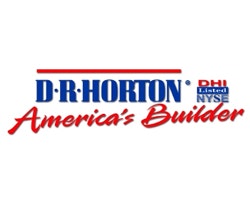Home builders stumbled in June on fear rising mortgage rates will derail demand. But, demand may not suffer as much as feared. If so, a more stable recovery and a longer runway for housing profits may be ahead.
That stability and profit potential may make it a good time buy shares in D.R. Horton, Inc. (NYSE:DHI), Lennar Corporation (NYSE:LEN) and Toll Brothers Inc (NYSE:TOL) for three reasons: strong sales and backlog support future revenue and profits; mortgage rates remain historically below average; and price-to-book values have retreated from their peaks.
New home construction remains strong
The number of new one-family homes sold in the U.S. in May totaled 476,000. That’s a solid increase from the 458,000 sold in January and well above last May’s 369,000. And, there’s more room to run since the median monthly new one-family homes sold since 1963 is 637,000.

Importantly, the pipeline for new home sales remains quite strong with 690,000 new homes completed in May. Those completions will show up in quarterly earnings this quarter. Increasingly, those completions are being sold for higher price tags too. The absence of inventory — there are only 4.1 months of new home inventory — helped median new home prices climb to $264,000 in May from $239,000 a year ago.

If you consider home building backlogs, the outlook for future sales and profit growth remains solid.
The number of new homes and the total value of those homes in D.R. Horton, Inc. (NYSE:DHI) and Lennar Corporation (NYSE:LEN)’s backlog are up roughly 55% and 76%, respectively, in the past year through last quarter. Backlog grew 52% and backlog dollar value expanded 69% at Toll Brothers Inc (NYSE:TOL).

Rates remain historically low
The main reason for selling builders stems from fear higher rates will push new home buyers to the sidelines. But, while some may delay purchases hoping for a return of low rates, others will jump in fearing rates will run higher. The net affect may simply smooth housing demand over time rather than curtail it.
Consider, the average 30 year mortgage rate is roughly 4.5%. This is still well below the median rate of 8.1% since 1971 and the 6.3% median rate from 2000 through 2007. This suggests rates would have to run much higher than they are currently to sink housing demand.

Add to historically low mortgage rates the dynamic of incredibly tight apartment supply and you get a significant incentive to shift from renting to buying. In Q1, REIS estimates apartment vacancies sank to just 4.3%. For comparison, the measure was 8% exiting 2009.
Home builder book values have been growing as the value of land climbs.
Why is book value important? Builders are relatively simple businesses. They buy land and build homes and book sales once they’re sold. If prices are increasing, the value of their assets helps show the true value of the assets on their balance sheet.
The growth in builder book value, combined with the recent share price drop, has made shares in these companies more attractive.
The price to book value at D.R. Horton, Inc. (NYSE:DHI) peaked in May at 2.3 and has since fallen to 1.9. At Lennar Corporation (NYSE:LEN), the measure has sunk from 2.4 to 2.0. And, the price-to-book ratio for Toll Brothers Inc (NYSE:TOL) peaked last fall at 2.2 and has since dropped to below 1.8.
Historically, you’ve been well served buying price-to-book values near 1 and selling price-to-book readings closer to 3. Since none of the three have price to book ratios near 3, it appears there’s more room to run.
Final word
Builders aren’t overbuilding and rates remain cheap based on home sales and mortgage rate history. This, combined with tight home supply and high rents, offers additional opportunity for builder revenue and profit growth.
But, is it the right time to take advantage of recent fears? While Fools shouldn’t buy and sell their holdings over and over, it can be helpful to consider seasonal cycles and their affect on share prices.
According to the Seasonal Investor database, all three company’s shares have historically been rewarded in the third quarter following late Q2 stumbles.
This suggests the industry wide sell-off in June was pretty much inline with prior years. While the past doesn’t guarantee the future, if trends play out as they have previously, now might be a good time to buy.
The article 3 Home Builders and 3 Reasons You Should Buy Them originally appeared on Fool.com.
Todd Campbell owns shares of D.R. Horton. The Motley Fool has no position in any of the stocks mentioned. Todd is a member of The Motley Fool Blog Network — entries represent the personal opinion of the blogger and are not formally edited.
Copyright © 1995 – 2013 The Motley Fool, LLC. All rights reserved. The Motley Fool has a disclosure policy.






